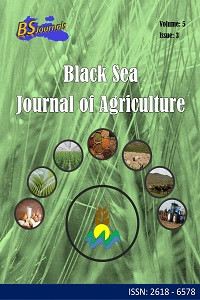Abstract
Animal production is valuable importance for human being and countries in terms of both economic and human nutrition. To increase the value of benefits from the livestock sector, there are many attempts to make policies. In this study, 26 different agricultural areas of Turkey according to their agricultural properties were clustered by using mammalian livestock existence such as cattle, water buffalo, sheep, goat and horse. For this aim 3-D clustering was applied using R software with FactoMineR and factoextra packages. The results showed that the number of 26 agricultural areas were clustered in four clusters. TR83 area including Samsun, Tokat, Çorum and Amasya cities was formed in a cluster lonely. The second cluster included agricultural areas of TRA2, TRC2 and TRB2 that these areas consist of the cities Ağrı, Kars, Iğdır, Ardahan, Şanlıurfa, Diyarbakır, Van, Muş, Bitlis and Hakkari. TRC3, TR62 and TR61 agricultural areas formed the third cluster including the cities of Mardin, Batman, Şırnak, Siirt, Adana, Mersin, Antalya, Isparta and Burdur. The other agricultural areas were included in the fourth cluster. These results are also important for traders' financial and human capital and trading practices such as the use of brokers and regular suppliers and customers had varying effects on margins and costs of animal trade. It is also amenable to public policy to improve the market environment and marketing efficiency.
References
- Atasever S. 2022. Change of animal production in Samsun province between 2010 and 2020. Turkish J Agri Food Sci Tech, 10(3): 388-393. DOI: 10.24925/turjaf.v10i3.388-393.4510.
- Ertaş N. 2019. Current livestock situation analysis according to level 2 classification, spatial and temporal distribution: example of TRB2. J Soc Sci Inst, 44: 11-39.
- İşler H, Ünlü Ören HG. 2021. Examination and SWOT analysis of the livestock sector in Burdur province. JASSFA, 3(7): 166-190.
- Önder H. 2019. Classification of villages in Bafra district according to small ruminant existence. BSJ Eng Sci, 2(4): 136-137.
- Tarhan S. 2021. Effects of young farmer project support on the development of livestock breeding enterprises. Eurasian J Agri Econ, 1(2): 1-17.
- Tirink C, Bayyurt L, Abaci SH, Onder H. 2019. Evaluation of dairy cattle milk production in Black Sea region by cluster analysis. BSJ Eng Sci, 2(2): 39-41.
- TUIK. 2021. Turkish Statistical Institute. URL: https: //tuik.gov.tr (access date: 10.05.2022).
- Şen U, Önder H, Şirin E, Özyürek S, Piwczynski D, Kolenda M, Ocak Yetisgin S. 2021a. Placental Characteristics Classification of Various Native Turkish Sheep Breeds. Animals, 11: 930. DOI: 10.3390/ani11040930.
- Şen U, Şirin E, Filik AG, Önder H, Piwczynski D, Kolenda M. 2021b. Growth and slaughter characteristics of weaning male kids of Turkish native goat breeds. Animals, 11: 2788. DOI: 10.3390/ani11102788.
- URL1: https://arastirma.tarimorman.gov.tr/gaputaem/ Belgeler/tar%C4%B1msal%20veriler/ gaputaem% 20gncel/HAYVANCILIK%20RAPORU%202015.pdf (access date: 10.05.2022).
Abstract
References
- Atasever S. 2022. Change of animal production in Samsun province between 2010 and 2020. Turkish J Agri Food Sci Tech, 10(3): 388-393. DOI: 10.24925/turjaf.v10i3.388-393.4510.
- Ertaş N. 2019. Current livestock situation analysis according to level 2 classification, spatial and temporal distribution: example of TRB2. J Soc Sci Inst, 44: 11-39.
- İşler H, Ünlü Ören HG. 2021. Examination and SWOT analysis of the livestock sector in Burdur province. JASSFA, 3(7): 166-190.
- Önder H. 2019. Classification of villages in Bafra district according to small ruminant existence. BSJ Eng Sci, 2(4): 136-137.
- Tarhan S. 2021. Effects of young farmer project support on the development of livestock breeding enterprises. Eurasian J Agri Econ, 1(2): 1-17.
- Tirink C, Bayyurt L, Abaci SH, Onder H. 2019. Evaluation of dairy cattle milk production in Black Sea region by cluster analysis. BSJ Eng Sci, 2(2): 39-41.
- TUIK. 2021. Turkish Statistical Institute. URL: https: //tuik.gov.tr (access date: 10.05.2022).
- Şen U, Önder H, Şirin E, Özyürek S, Piwczynski D, Kolenda M, Ocak Yetisgin S. 2021a. Placental Characteristics Classification of Various Native Turkish Sheep Breeds. Animals, 11: 930. DOI: 10.3390/ani11040930.
- Şen U, Şirin E, Filik AG, Önder H, Piwczynski D, Kolenda M. 2021b. Growth and slaughter characteristics of weaning male kids of Turkish native goat breeds. Animals, 11: 2788. DOI: 10.3390/ani11102788.
- URL1: https://arastirma.tarimorman.gov.tr/gaputaem/ Belgeler/tar%C4%B1msal%20veriler/ gaputaem% 20gncel/HAYVANCILIK%20RAPORU%202015.pdf (access date: 10.05.2022).
Details
| Primary Language | English |
|---|---|
| Subjects | Zootechny (Other) |
| Journal Section | Research Articles |
| Authors | |
| Publication Date | July 1, 2022 |
| Submission Date | May 16, 2022 |
| Acceptance Date | June 17, 2022 |
| Published in Issue | Year 2022 Volume: 5 Issue: 3 |


